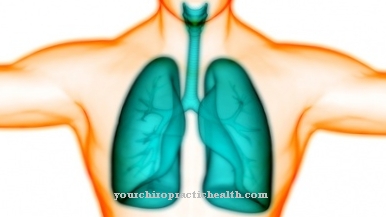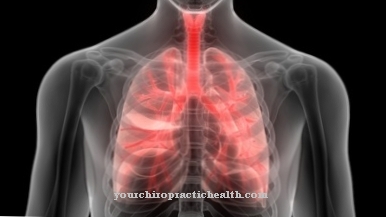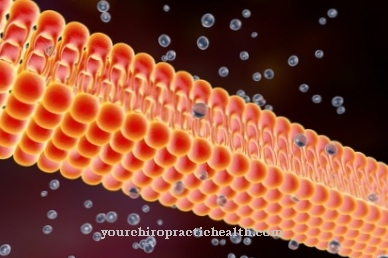The Epibolism is a cell movement of gastrulation, which in principle corresponds to intussusception. The prospective endoderm is overgrown by the prospective ectoderm. Disorders of the epibolism occur, for example, when the function of the molecule fibronectin is lost and can trigger miscarriages.
What is the epibolism?

During the gastrulation, the blastocyst invades. In the course of the process, the three cotyledons form, from which the individual anatomical structures of the embryo develop.
Immediately after fertilization, the future cells of the embryo are omnipotent. The formation of the three cotyledons corresponds to a first differentiation of the omnipotent cells. During the embryonic development, the formerly omnipotent cells then gradually become organ-specific tissue.
The formation of the three cotyledons during gastrulation is a basic requirement in this context. In biology, the cotyledons are called the endoderm, mesoderm and ectoderm. All specific tissues of the later individual emerge from them through processes of division. Gastrulation is similar for all multicellular cells and is characterized by different cell movements. One of them is epibolism, which usually follows the movement of delamination.
In epibolism there is an active overgrowth of the yolk-rich blastula part. In meroblastic eggs with an extreme proportion of yolk, the cotyledons grow around the unfolded yolk, for example in the gastrulation of the bony fish. The epibolism thus corresponds in principle to an intussusception in which the prospective endoderm is overgrown by the prospective ectoderm.
Function & task
Three germ layers are formed during the early embryogenesis of multicellular cells. The starting material for the formation of the cotyledon is called the blastula in lower mammals and the blastocyst in higher mammals such as humans.
The process of cotyledon formation is also known as gastrulation and encompasses several cell movements that have not yet been fully researched and understood. In addition to intussusception, involution, ingression and delamination, epibolism is one such cell movement.
During intussusception, the future endoderm turns inside the blastocoel of the blastula, so that the endoderm forms as the inner cell layer and the ectoderm as the outer cell layer. This is followed by involution, in which the endoderm curls up. During the subsequent ingression or immigration, cells of the endoderm migrate into the blastula and are pinched off into the blastocoel during the subsequent delamination of blastula cells.
With yolk-rich eggs, the epibolism now takes place, which in principle corresponds to intussusception. This cell movement is characterized by overgrowth of the future endoderm, which is carried out by cells of the prospective ectoderm. The epibolism is understood as the first coordinated cell movement and begins during the completion of the blastula stage.
All cell layers go through an epibolism. The inner cells of the blastoderm move in the direction of the outer cells and overlap. The blastoderm spreads towards the vegetative embryonic pole until it has fully encompassed the yolk cells. The cells of the envelope increase their surface area and spread in a similar way.
In the front part, the cells align. The yolk layer moves again in the direction of the vegetative pole during epibolism and spreads along the yolk surface. After the epibolism has ended, the envelope layer, the yolk layer and the deeper cells of the blastoderm have completely grown around the yolk cells.
The molecule fibronectin is assigned a major role in epibolism. Signaling pathways such as the Wnt / PCP pathway, the PDGF-PI3K pathway, the Eph-Ephrin pathway, Jak-Stat signaling and the MAP kinase cascade also play a role in cell movement.
Illnesses & ailments
In the first few days after fertilization of an egg cell, errors in embryonic development can occur. If such errors occur, the fertilized egg usually does not implant in the first place. The result is a miscarriage that does not cause any symptoms and is usually not even noticed by the miscarriage.
In most cases, this type of miscarriage is not a pollution-related complication. The small creature is not particularly susceptible to external pollutants until the cotyledons are formed. However, this changes as soon as the primitive streak forms. From the third week after fertilization, external pollutants can cause disturbances in the development of the embryo and have tragic consequences.
If the cell movements of the gastrulation are disturbed, the three germ layers either cannot form at all or they form in an unforeseen way. Disorders in epibolism can arise, for example, from a loss of function of the fibronectin molecule.
Disturbances in the other signaling pathways involved in epibolism can also lead to cell movement not occurring at all, only inadequately or to a pathological extent. On the basis of such disorders, the envelope layer, the yolk layer and the deeper cells of the blastoderm do not grow around the yolk cells completely or not at all. The result is usually a miscarriage. Unlike the first few days and weeks after conception, this type of miscarriage is symptomatic and perceived by the miscarriage.

























.jpg)


